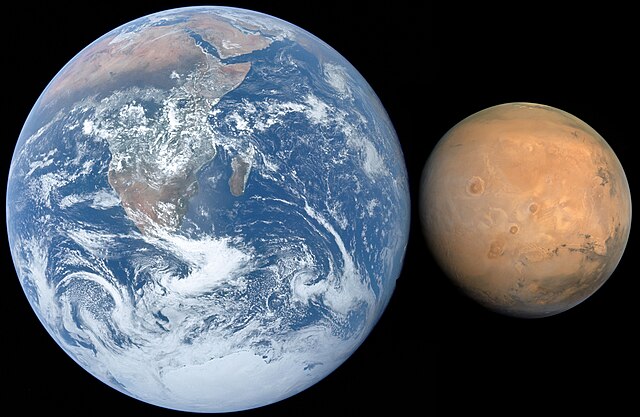The geology of Mars is the scientific study of the surface, crust, and interior of the planet Mars. It emphasizes the composition, structure, history, and physical processes that shape the planet. It is analogous to the field of terrestrial geology. In planetary science, the term geology is used in its broadest sense to mean the study of the solid parts of planets and moons. The term incorporates aspects of geophysics, geochemistry, mineralogy, geodesy, and cartography. A neologism, areology, from the Greek word Arēs (Mars), sometimes appears as a synonym for Mars's geology in the popular media and works of science fiction. The term areology is also used by the Areological Society.
Mars as seen by the Hubble Space Telescope
Viking Orbiter 1 view image of Valles Marineris.
Mars Orbital Laser Altimeter (MOLA) derived image of Planum Boreum. Vertical exaggeration is extreme. Note that residual ice cap is only the thin veneer (shown in white) on top of the plateau.
HiRISE image of simple rayed crater on southeastern flank of Elysium Mons.
Mars is the fourth planet from the Sun. The surface of Mars is orange-red because it is covered in iron(III) oxide dust, giving it the nickname "the Red Planet". Mars is among the brightest objects in Earth's sky, and its high-contrast albedo features have made it a common subject for telescope viewing. It is classified as a terrestrial planet and is the second smallest of the Solar System's planets with a diameter of 6,779 km (4,212 mi). In terms of orbital motion, a Martian solar day (sol) is equal to 24.5 hours, and a Martian solar year is equal to 1.88 Earth years. Mars has two natural satellites that are small and irregular in shape: Phobos and Deimos.
Comparison: Earth and Mars
Curiosity's view of Martian soil and boulders after crossing the "Dingo Gap" sand dune
Valles Marineris, taken by the Viking 1 probe
Edge-on view of Mars atmosphere by Viking 1 probe








